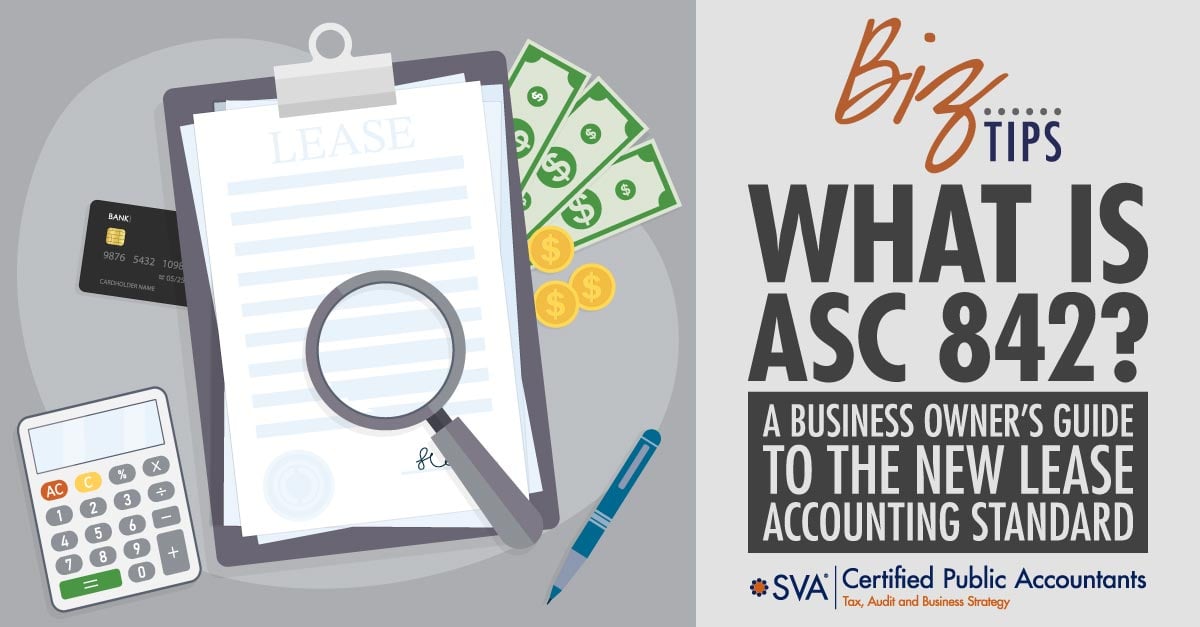Lease accounting has looked a little different in recent years, thanks to the adoption of ASC 842. The updated standard changes how leases are recognized on financial statements, giving lenders, investors, and business owners a clearer picture of a company’s financial position.
Rebecca Muehl, a Principal at SVA Certified Public Accountants, specializes in assurance services for closely held businesses across industries such as real estate, construction, professional services, and manufacturing. She advises clients on internal controls, financial reporting, and evolving accounting standards.
In this Q&A, she shares her insights on ASC 842: how it affects balance sheets, introduces new challenges, and continues to shape financial reporting for businesses.
What is ASC 842?
ASC 842 is the new lease accounting standard that “takes all your leases, regardless of classification, and puts them on your balance sheet,” Rebecca explains.
Previously, operating leases were recorded as rent expenses on the income statement. “Now,” she says, “you’re going to recognize a right-of-use asset and a related lease liability that will appear on the balance sheet.”
The goal, she adds, is transparency: “It makes it really clear to the users of the financial statements, like banks or sureties, that you have a long-term lease and the related liability. They can see it right on your balance sheet rather than having to dig into the footnotes of the financial statements.”
Who Does ASC 842 Apply To?
The short answer: almost everyone. “It applies to all entities that enter into lease agreements, from small private companies to large public corporations,” Rebecca says.
However, there’s one practical expedient allowed for short-term leases. If you have a lease that is 12 months or less, you don’t have to put that on your balance sheet. These short-term leases are still disclosed but not capitalized.
Why Does ASC 842 Matter?
The most noticeable effect of ASC 842 is how it changes the look of a company’s balance sheet. “It really beefs up your assets,” Rebecca says. “You’re putting assets on your books that you don’t technically own.” For example, if a company rents office space under a five-year agreement, that lease now appears as a right-of-use asset on the books.
The flip side is that liabilities also increase. “Those liabilities on your balance sheet are quite a bit higher than what they have been in the past,” she adds. That shift can impact financial ratios, which in turn may influence lending decisions.
“With that liability creeping up,” Rebecca notes, “banks may see liquidity and leverage ratios change, and it’s important to help them understand how the new standard affects those numbers.”
How Has Lease Accounting Become More Complex?
Under ASC 842, lease accounting goes beyond tracking monthly rent. “There’s a lot of little intricacies in the standard,” Rebecca says. “You have to look at things like variable lease payments and other components of the lease agreement that could include common area maintenance charges, utilities, or real estate taxes. Every contract is different.”
That level of detail makes technology invaluable, and it’s important to have a tool to track the different terms of your contract. “It’s really important to have some kind of tool for tracking all the different terms of your contract,” she explains.
What Implementation Challenges Should Businesses Expect?
For many companies, implementation starts with identifying all leases; and that’s not always straightforward. “You might have a contract with a service provider, and they give you equipment that enables you to utilize that service,” Rebecca says. “That equipment might actually be a lease.”
Other challenges include managing transition disclosures and maintaining strong internal controls. “You really want someone on staff who’s familiar with the standard,” she advises. “They don’t have to be an expert in every detail, but they should know what questions to ask and how to review the disclosures to catch any misstatements.”
What Are the Practical Expedients Under ASC 842?
Rebecca points out that the standard offers a few ways to simplify compliance. “If you have a one-year lease, you can elect a practical expedient and not put it on the balance sheet,” she says.
There are also options for grouping lease and non-lease components together. “You can decide not to break a contract into parts and just treat the whole thing as a lease,” she explains. “It saves time and effort on the accounting side.”
How Does ASC 842 Affect Financial Ratios and Lending Relationships?
Adding lease liabilities to the balance sheet can alter how financial health is perceived. “Recognizing new lease liabilities increases total debt,” Rebecca says. “That can change key ratios like the current ratio or debt-to-equity ratio.”
For companies with active loan covenants, she recommends proactive conversations with lenders. “We’ve worked with clients and their banks to help everyone understand how ASC 842 impacts their financials,” she notes. “It’s often just a matter of explaining what’s changed and why.”
(Download Video Transcript)
What Comes Next?
Although the initial adoption period has passed, companies should continue monitoring how lease changes affect their financials. “Going forward, it’s really important to look at any lease modifications,” Rebecca advises. “If you add more space, extend a lease, or renegotiate terms, that can require remeasurement or even be treated as a new lease.”
ASC 842 may have added complexity, but it also creates a more complete picture of a company’s commitments. As Rebecca puts it, “It gives everyone—owners, lenders, auditors—a clearer view of what’s really happening with your business.”
© 2025 SVA Certified Public Accountants

